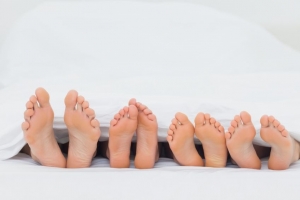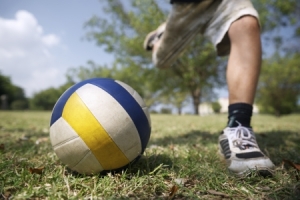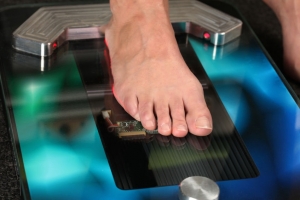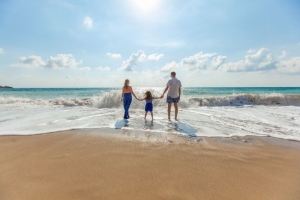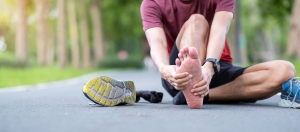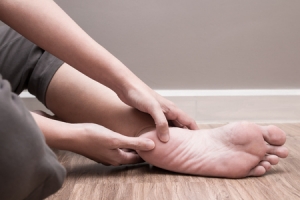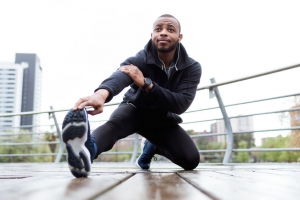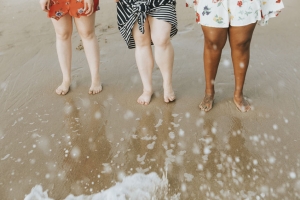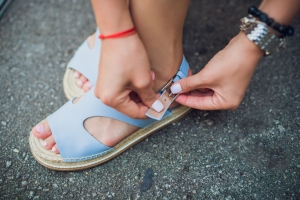Connect With Us
Blogs
10 Fun Facts About Feet
At Superior Foot & Ankle Care Center we want our Los Angeles County patients to appreciate their feet. All too often it’s easy to take our feet for granted–until they start to hurt or stop functioning the way they should to enable us to live our active and busy lives. We’d like to call your attention to some amazing facts about your feet that you may not know.
- It takes a lot to build a good foot! Together your feet have 52 bones (which is about 25% of the total bones in your body), 66 joints, 38 muscles, 20 tendons, and 214 ligaments.
- Your feet contain approximately 8,000 nerves–more per square centimeter than any other part of your body. Anybody feeling ticklish?
- The Achilles tendon is the longest and strongest tendon in your body. It’s also the most injury-prone.
- It’s no wonder feet tend to get sweaty. They contain 250,000 sweat glands which can pump out about half a pint of perspiration every day.
- With every step you walk, each of your feet absorbs one and half times your body weight. When you run, your body is hit with the force of up to five times your body weight. Over just one day feet are hit with a couple of tons of pressure.
- Want to go for a walk? On average, a person logs 115,000 miles in a lifetime–this is about the distance of about 5 trips around the earth.
- To grow out a toenail completely takes 12-18 months.
- Women suffer from foot and ankle problems four times more often than men do. This is usually linked to the shoes they wear.
- It’s common for people to have one foot that’s bigger than the other. You should always buy shoes to fit the larger foot.
- All babies have flat feet. The arch of the foot does not develop until the age of 3.
Now that you know more about your feet and how truly wonderful they are, take steps to ensure they stay healthy all your life. Making healthy lifestyle choices, wearing quality shoes that fit properly, and contacting our Long Beach office at (562) 420-9800 office for an appointment as soon as you notice any pain or concerning symptoms in your feet and ankles are all good ways to be proactive in the health of your feet. Our podiatrists, Dr. Victoria M. Foley and Dr. Constance Ornelas, will track down the source of your discomfort promptly and prescribe the correct treatment to get you back on track.
Healthy Lifestyle Choices Improve Juvenile Arthritis Symptoms
At Superior Foot & Ankle Care Center we treat podiatric problems in Los Angeles County patients of all ages. In July, we recognize Juvenile Arthritis Awareness Month. Nearly 300,000 children and teenagers suffer from Juvenile Arthritis (JA). Some forms are similar to the types of arthritis that adults suffer from, and some are unique to young people.
Many types of JA are autoimmune or autoinflammatory in nature, meaning that the immune system mistakenly attacks healthy tissue with inflammatory chemicals. These can cause joint pain and inflammation, and skin disorders, and internal organ issues. If your child is experiencing joint pain in their feet or ankles, the first step is to make an appointment at our Long Beach office at (562) 420-9800 office so that our podiatrists, Dr. Victoria M. Foley and Dr. Constance Ornelas, can examine your child and determine if the discomfort is strictly podiatric or if arthritis or another disease may be the source. Once a diagnosis is determined, the foot doctor will advise you on treatment or refer you to a specialist in the area of concern. Just as with adults, healthy lifestyle choices can play a key role in managing JA and preventing its progression. Below are three to focus on:
Exercise—Although some types of movement may be painful for children and teens with joint disorders, regular exercise and physical activity is also one of the best weapons in the fight against arthritis. Depending on your child’s age, they may need help finding the activity that best suits their particular type of arthritis. Some good choices include swimming and aquatic classes (the buoyancy of the water naturally reduces pressure on the joints), biking and yoga. Expose your child to several different activities and as they mature, they will gravitate to those that best suit them.
Nutrition—Lower weight means less pressure on joints, especially those in the knees, ankles, and feet. Some foods are also known to decrease inflammation while others spark an inflammatory response. Make healthy eating a family habit and involve your children in choosing nutritious foods and then preparing and eating them together.
Mental Health—Growing up is hard enough without having a chronic disease. Make sure your child has a good support network, spends time with friends, and participates in activities that build confidence. Model positive coping skills for your child and seek professional help if necessary.
FAQ’s about Custom Orthotics
At Superior Foot & Ankle Care Center we often get questions from our Los Angeles County patients about custom orthotics. Below are some of the most frequently asked questions about this very effective, non-invasive type of podiatric treatment.
Q: What conditions can orthotics help treat?
A: Orthotics are footwear inserts that are used to provide support and reduce pain, discomfort, pressure or imbalance, and other symptoms caused by a wide range of foot and ankle deformities, injuries, and diseases as well as biomechanical problems. Some common conditions that can be treated with orthotics include flat feet, heel pain, arthritis, bunions, calluses, corns, big toe pain, and neuropathic ulcerations.
Q: What’s the difference between over-the-counter shoe inserts and custom orthotics?
A: Over-the-counter inserts can provide some arch support and treat minor discomfort and pain. Prescription orthotics, however, are made from a mold of your unique foot and therefore better able to address and correct your specific foot issues. Prescription orthotics are also constructed of more durable materials and can last a long time.
Q: What are some common kinds of prescription orthotics?
A: Orthotics come in many shapes and sizes and are made from a variety of materials depending on individual needs. They may take the form of insoles, arch supports, heel pads, or foot cushions. Generally, there are two classifications of orthotics. Accommodative orthotics offer cushioning and reduce pressure on a vulnerable area of the foot. Functional orthotics are used to treat foot problems caused by foot and ankle motion and alignment.
Q: How are custom orthotics made?
A: The first step is to have our podiatrists, Dr. Victoria M. Foley and Dr. Constance Ornelas, conduct a thorough examination of your feet and ankles and evaluate how they are impacting your knees, legs, and lower back. Once the foot doctor has a diagnosis of your podiatric disorder and a complete understanding of the biomechanics of your foot, a mold of your foot will be made from a plaster cast or a specialized computer scan that maps your foot structure and your gait. The podiatrist will then check to make sure the orthotic is fitted properly and monitor your progress.
If you would like to learn more about orthotics and whether or not they can help you, contact our Long Beach office at (562) 420-9800 office for an appointment today.
Avoiding Podiatric Problems at the Beach
At Superior Foot & Ankle Care Center we know that our Los Angeles County patients are within driving distance of many beautiful California beaches. This favorite summertime excursion, however, can end in pain and discomfort for your feet or ankles if you fail to take the proper precautions. Below are some beach-day fun busters and how to prevent them.
Burns—while sunburn is an obvious concern that most people are aware of on a beach day, we find that many patients neglect to apply sunscreen diligently to their feet. It’s essential to use a water-resistant, broad-spectrum sunscreen that protects against both UVA and UVB rays with an SPF of at least 30. Be sure to apply the sunscreen to the tops and bottoms of your feet. Sitting in a sand chair the soles of your feet are exposed to direct sunlight and reflective rays off the sand. Reapply sunscreen to your feet after swimming or every two hours, whichever comes first.
Walking on hot sand or pavement can also cause the soles of your feet to burn. It may seem like a short trip to get to your beach blanket, but the temperatures of the sand can easily heat up enough to cause third-degree burns to the skin in a very short time. Always cover your feet before stepping out.
Jelly Fish Sting—Did you know that these creatures can still sting you even after they have washed up on the shore and died? Pack a small container of vinegar or baking soda in your beach bag and apply it to a jellyfish sting to relieve pain. Most stings will heal on their own within a few days. If yours appears to be getting worse instead of better, contact our Long Beach office at (562) 420-9800 office for an appointment so that our podiatrists, Dr. Victoria M. Foley and Dr. Constance Ornelas, can examine your wound and determine if it has become infected.
Ankle Sprain—some people enjoy adding a little sports activity to their beach day with a game of beach volleyball or frisbee. If you fall into this category, remember to bring sneakers to support your feet in sliding sands to avoid ankle sprains and other injuries.
Puncture Wound—sharp objects can easily be concealed in the sand. Wear shoes for beach walks to avoid cuts. If you do get a cut, clean it immediately and put antibacterial ointment and a bandage on the wound.
We hope you have lots of summer fun! If you have any foot or ankle issues, contact us for evaluation and treatment.
Corns and Calluses on Your Feet
At Superior Foot & Ankle Care Center some of the problems our Los Angeles County patients bring to us most frequently are caused by repetitive friction and pressure being applied to the feet. Below are two common podiatric conditions of this type and what’s behind them.
Corns—typically corns appear on the tops and sides of the toes or between toes. They are the result of pressure from footwear or toes on toes and are often a secondary condition that develops as the result of a deformity such as a bunion, hammertoe, or claw toe. The deformity makes it difficult to fit into shoes and the constant pressure to a spot that is out of place or enlarged causes the corn to form.
Calluses—calluses are thickened patches of skin that are hard and tough. Although the problem manifests on the surface of your skin, the source is usually much deeper in the foot. Calluses are the result of long-term pressure to a specific spot, and they most often develop on weight-bearing parts of the foot like the heel, sole, ball of the foot, or big toe. Since the issue with a callus is more than skin deep, there may be inflamed nerves or bone deformity involved as well.
Treatment Options
Both corns and calluses can be treated at home by soaking them in warm, soapy water and then using a pumice stone or foot file to gently smooth and reduce them. Apply a rich moisturizer afterward to keep the skin soft. However, the best course of treatment is to consult our podiatrists, Dr. Victoria M. Foley and Dr. Constance Ornelas, to determine the root cause of your corn or callus. It’s unlikely that the problem will be resolved completely until the underlying cause of the friction or pressure is identified and treated.
If corns or calluses are causing you pain and making it difficult to find comfortable shoes, contact our Long Beach office at (562) 420-9800 for an appointment at your earliest convenience.
Sports Injury Lessons from Summer Olympians
At Superior Foot & Ankle Care Center we’re sure many of our Los Angeles County patients are following the athletes and events connected to the long-awaited Summer Olympics scheduled to take place in Tokyo later this summer. Along with thrilling competition, there’s sure to be some sports injuries such as the one sustained by Canadian shot put thrower, Brittany Crew. Crew was competing in Arizona at the Tucson Elite Classic in May when she suffered a freak accident that resulted in a Grade 2 sprain to her right ankle. When her left foot hit the toe board it slid, unexpectedly shifting all the force to the right ankle. Crew remembers hearing a pop and then her ankle went numb.
Treating Ankle Sprains
Fortunately, Crew is well on the road to recovery, and it looks like she should be in top form to compete in the Olympics. She has, however, decided to sit out the Olympic Trials in order to give her ankle additional time to heal. This wise move exemplifies one of the most important factors in recovering from an ankle injury: not rushing the rehabilitation. Unfortunately, many patients cut physical therapy short once their ankle stops hurting and this leads to the number one cause of repeated ankle sprains which is not recovering fully from an initial sprain. In addition to overstretched ligaments, the muscles that surround and support the ankle need to get stronger and this takes additional time. Other steps to achieving a full recovery include:
- Get medical treatment as soon as possible—ankle sprains require professional assessment. The severity of the sprain may not be obvious to the patient. Sometimes a sprain injury has also caused a fracture. Continuing to walk or play on a sprained ankle can lead to a worse injury. Contact our Long Beach office at (562) 420-9800 office for an appointment as soon as possible after an ankle-twisting injury so that our podiatrists, Victoria M. Foley and Dr. Constance Ornelas, can evaluate your injury and determine the best course of treatment.
- Use RICE—this self-treatment regimen is the best way to control pain and prevent further damage while you await your appointment. It stands for Rest, Ice, Compression, and Elevation.
- Follow the podiatrist’s instructions—you may need to take a break from a favorite sport to allow time to heal, use an ankle brace, or complete other treatment protocols to get back to full and normal use of your ankle but—take it from an Olympic athlete—it’s worth it!
3 Causes of Back of Heel Pain
At Superior Foot & Ankle Care Center we know that pain at the back of your heel can be quite debilitating. What starts as an annoying ache can quickly turn into excruciating pain that makes walking difficult. For our Los Angeles County patients that may be experiencing these uncomfortable symptoms, here are three possible causes.
Haglund’s Deformity—this is a bony enlargement that forms at the back of your heel. This condition may be the result of an inherited structural issue like a high arch or a tight Achilles tendon. It can also be caused by wearing shoes with stiff backs that rub on the heel—hence this deformity’s other name: pump bump.
Bursitis—small sacs that are filled with fluid—known as bursas—are found throughout the body near joints and bones. They serve as protection from friction and provide a little extra lubrication. When a bursa becomes irritated due to repetitive motion or pressure it can become painfully inflamed. Haglund’s deformity is one cause of bursitis but it may also be the result of repetitive action from exercise or another medical condition such as gout, diabetes or arthritis.
Achilles Tendonitis—this long tendon that runs down the back of your lower leg connects your calf muscle to the heel bone. It can be aggravated or injured from overuse such as someone whose job involves climbing a ladder. Athletes and “weekend warriors” who suddenly increase the intensity of their workout routine may also suffer from Achilles issues.
The only way to find out for sure what’s causing your back of heel pain is to let our podiatrists, Dr. Victoria M. Foley and Dr. Constance Ornelas, examine your foot and conduct the necessary tests to get to the bottom of the problem. You can contact our Long Beach office at (562) 420-9800 office for an appointment. To learn more about foot health and conditions we treat check out our video library.
Celebrating Men’s Health Month
Each June we recognize Men’s Health Month and at Superior Foot & Ankle Care Center we think it’s a great opportunity to share with our Los Angeles County patients some tips for improving foot health for men.
One of the biggest differences in the way men and women approach health care, in general, is that women tend to be more proactive in taking care of health issues. Studies show that men are more likely to put off seeing a doctor until a problem is really bad. When it comes to your feet (and the rest of your body), detecting disorders in their earliest stages leads to quicker and more successful outcomes.
Here are some suggestions for keeping men’s feet healthier:
- Commit to basic foot care. No, it doesn’t have to be complicated or time-consuming. It can be as simple as washing your feet daily with soap and water and always starting the day with clean socks and a dusting of foot powder to help keep feet dry. This will reduce the risk of fungal infections.
- Give your feet the once over weekly. Looking at your feet can help you spot changes that may indicate a developing problem. Did you know that your feet can help detect health concerns like high blood pressure and diabetes? Swelling, hair loss on your toes or feet, and discoloration of the skin are a few of the indicators that something bigger may be going on in your body. If you see anything unusual, contact our Long Beach office at (562) 420-9800 office promptly for an appointment so that our podiatrists, Dr. Victoria M. Foley and Dr. Constance Ornelas, can examine your feet and determine if there’s an issue.
- Buy good shoes. One of the biggest ways to keep your feet healthy is to wear good-quality shoes that fit properly. Get rid of shoes with worn-down soles, stretched-out heels, holes, or other signs of wear. Avoid shoes that are too tight in the toe box to help prevent ingrown toenails. Always wear athletic shoes designed for the sport or fitness activity you are doing.
- Protect feet on the job. If you are a construction worker or deal with harmful chemicals or toxic materials always wear protective footwear.
- Live a healthy lifestyle. Maintaining a healthy weight, eating a nutritious diet, regular exercise, and getting enough sleep will all benefit your feet as well as the rest of your body.
If you have specific questions about a foot issue, don’t hesitate to contact us.
Avoid These 4 Podiatric Pitfalls on Vacation
At Superior Foot & Ankle Care Center we know many of our Los Angeles County patients can’t wait to take a vacation. After a year plus of Covid restrictions, you’ve got places to go and people to see! Our goal is to make sure a painful foot problem doesn’t slow you down. Below are four potential pitfalls you’ll want to avoid on your summer vacation.
- Not Wearing Socks with Sandals—Yes, you read that right. While normally wearing socks with sandals would be a fashion “faux pas,” if your trip starts with an airplane flight it’s highly encouraged. Most security checks require you to remove your shoes. Every person who walks with bare feet through the scanner machine has the potential to leave behind bacteria or fungi that can result in athlete’s foot, fungal toenails or another infection which are passed on by direct contact for the people who follow them.
- Getting New Shoes for Vacation—It’s great to find the perfect pair of shoes to go with your new shorts and sundresses, but packing them before wearing them can be a big mistake. Even though you should always try on both shoes when purchasing and spend some time in the store walking around, new shoes can still surprise you with blisters or rubbing in places you didn’t expect. Try them out at different times (your feet are largest and most swollen at the end of the day) for a day or two before you go to make sure they are comfortable and pain-free.
- Being a Bare-Foot Beach Bum—With the sun beating down on it, the sand at the beach can heat up to over 100 degrees F. Even a few steps from the parking area to your beach blanket can result in dangerous blistering burns to the soles of your feet. If you like to take walks on the beach, a pair of water shoes can also help you avoid sharp objects that can cause puncture wounds and other hazards like jellyfish that have washed up on the shore.
- Forgetting to Pack Foot Care Essentials—Even if you’re only traveling with a carry-on bag you should have room for a few small items that can make a big difference in foot comfort while on vacation. If our podiatrists, Victoria M. Foley and Dr. Constance Ornelas, have prescribed a custom orthotic, don’t leave it home! It’s also a good idea to bring moleskin to prevent painful blisters, foot powder, nail clippers, and an emery board.
We hope you and your family have a great vacation this summer. If you find a foot or ankle is hurting you when you return, or you notice other unusual symptoms in your feet, be sure to contact our Long Beach office at (562) 420-9800 office promptly for an appointment.
Summer Shoe Do’s and Don’ts
At Superior Foot & Ankle Care Center we know that many of our Los Angeles County patients welcome the summer season and the shoe wardrobe that accompanies it. While it’s always fun to wear fashionable footwear that suits the season our podiatrists, Dr. Victoria M. Foley and Dr. Constance Ornelas, always have the health and safety of your feet as a top priority. Below are some do’s and don’ts to consider when making summer shoe choices:
Do: contact our Long Beach office at (562) 420-9800 to schedule an appointment with our podiatrists if you have a chronic foot condition and require specific shoe style recommendations.
Do: make sure all your summer shoes fit properly. Discard shoes that hurt your feet whenever you wear them. Get your feet professionally measured when buying new summer shoes.
Do: use flip flops around the town pool, at the beach and other public places where there are lots of bare feet. This will help prevent common fungal infections like athlete’s foot and toenail fungus. Don’t use these shoes as your daily summer footwear choice, however, unless you buy upgraded versions that feature arch support and more structure to prevent injuries.
Don’t: forget to apply sunscreen to your feet when wearing sandals and other open styles that expose the skin on your feet.
Do: consider wedge-style heels over spikes for greater stability and reduced risk of ankle sprains.
Do: alternate the heel heights on the shoes you wear to prevent repetitive strain on your Achilles tendon and calf muscles. Avoid heels that are over two inches.
Don’t: wear flats for heavy walking days. While they may feel comfortable initially, the lack of an arch will ultimately lead to heel pain and discomfort.
Don’t: wear flip-flops for beach volleyball or sandals for hiking. Always choose the right shoe for the activity you are doing.
Do: wear socks with your sneakers to prevent blisters and absorb sweat. Change your socks as soon as you notice they feel damp. Fungal infections thrive in moist, dark places.
Do: keep moleskin with you to apply to any spot on your foot that feels like it might be forming a blister.
